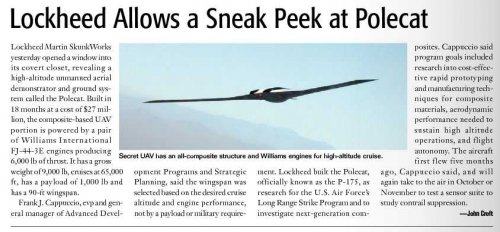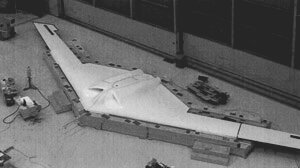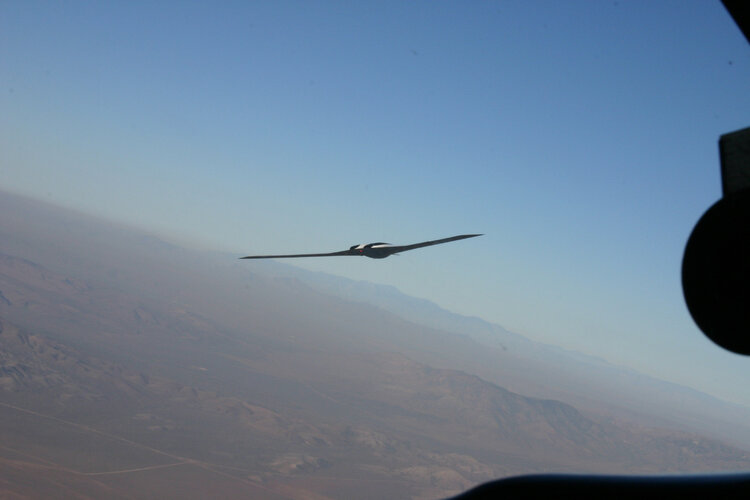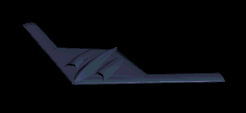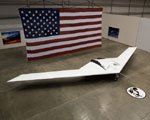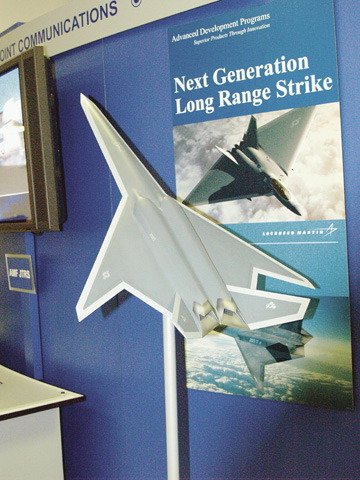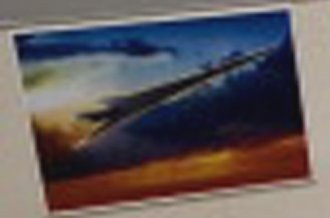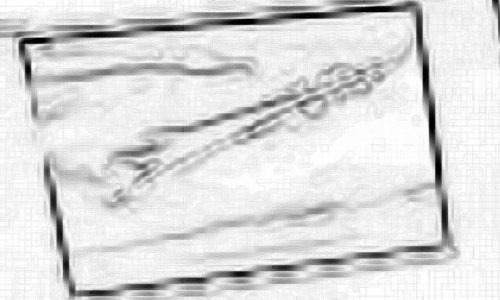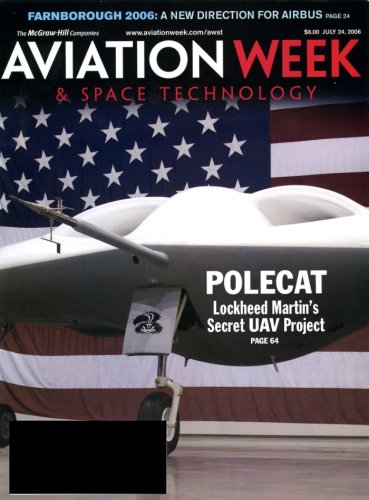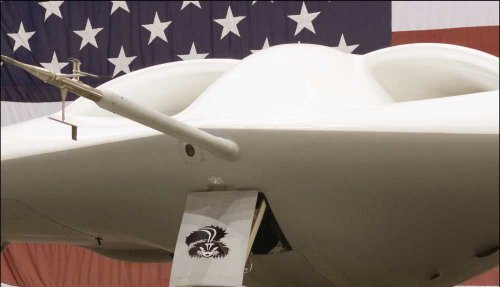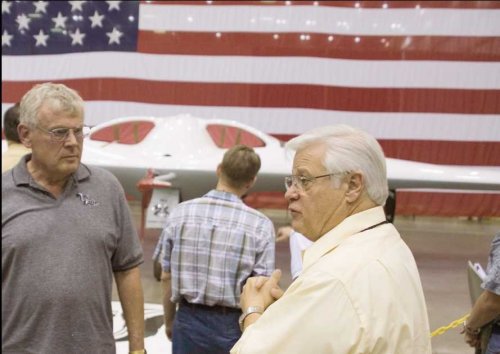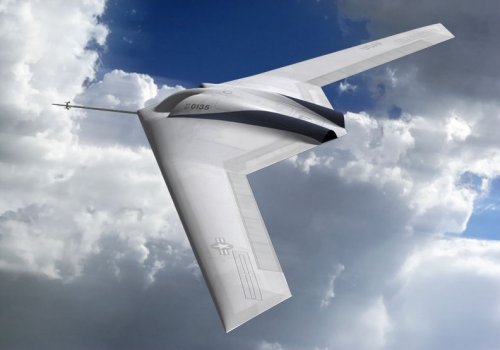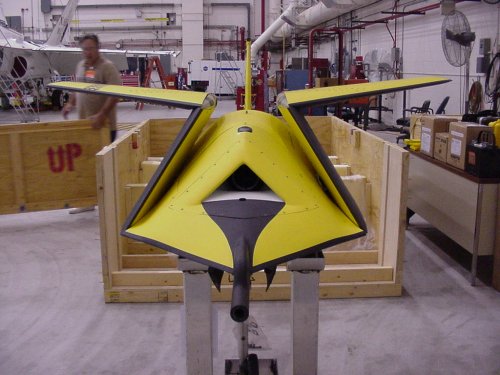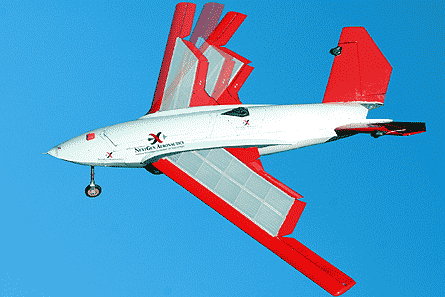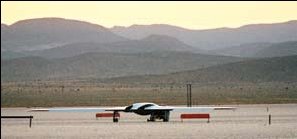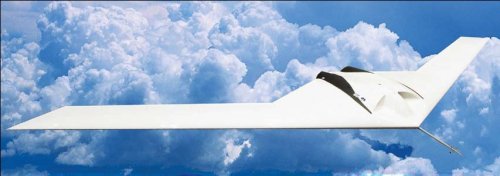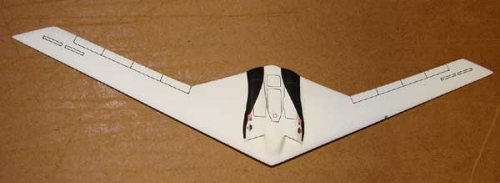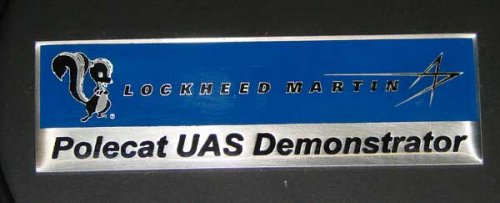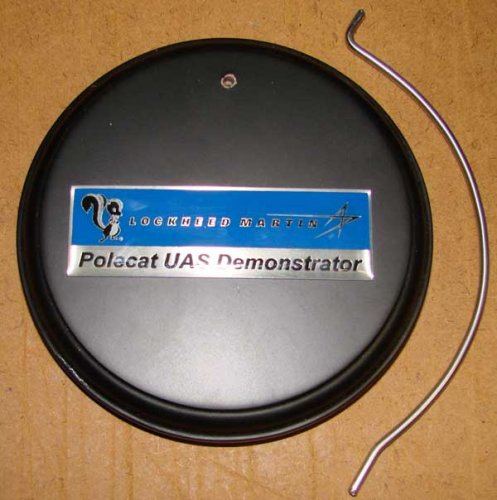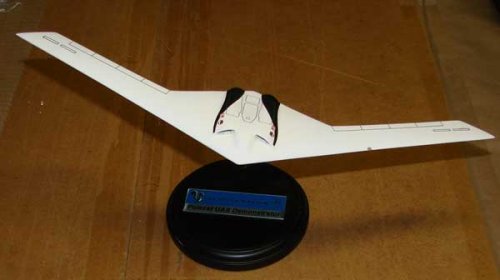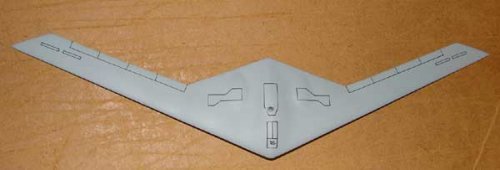You are using an out of date browser. It may not display this or other websites correctly.
You should upgrade or use an alternative browser.
You should upgrade or use an alternative browser.
Lockheed Martin SkunkWorks P-175 Polecat UAV
- Thread starter flateric
- Start date
Matej
Multiuniversal creator
Now we have the answer to rumours about that cancelation of Tier 3- DarkStar was not the end of the research 
- Joined
- 3 June 2006
- Messages
- 3,094
- Reaction score
- 3,964
LOCKHEED MARTIN'S SKUNK WORKS REVEALS HIGH ALTITUDE UNMANNED SYSTEM
From the top the fuselage reminds me very much of X-47 and the Lockheed's ATB concept but without the tail boom.
From the top the fuselage reminds me very much of X-47 and the Lockheed's ATB concept but without the tail boom.
Attachments
Last edited by a moderator:
- Joined
- 3 January 2006
- Messages
- 1,223
- Reaction score
- 943
Does anyone else wonder why this program has gone from the "black" to "white?"
Is this a scalled down "proof of concept" for the 50 tonne UCAV that the Air Force so desperately wants, or is this a prelude to a large production buy of smaller, cheaper UCAVs?
Has the program "broken cover" to gain political backing for the production stage?
Is this a scalled down "proof of concept" for the 50 tonne UCAV that the Air Force so desperately wants, or is this a prelude to a large production buy of smaller, cheaper UCAVs?
Has the program "broken cover" to gain political backing for the production stage?
Matej
Multiuniversal creator
fightingirish said:
From where is that picture? Looks interesting.
- Joined
- 3 June 2011
- Messages
- 18,338
- Reaction score
- 12,240
Could be like Tacit Blue, Bird of Prey, etc. and they've "broken cover" because it's old news. Or it could be to dispell the question of "well Boeing and Northrop are busy with UCAV demonstrators, what is Lockheed doing?" Also it makes you wonder if this is the "upscaled Dark Star" that has been rumored.
This art is over 10 years old. I downloaded it from a site (sorry I can't remember the site-- my apologies to the site owner), and it was labeled Lockheed Tier III URAV. I think it looks very much like Polecat!
 I hope I got the pic to show.
I hope I got the pic to show.
Matej
Multiuniversal creator
Sentinel Chicken
American 71 Heavy, contact departure 126.47
So I guess no one picked up the sense of humor from the Skunk Works folks in naming this aircraft "Polecat"?
- Joined
- 1 April 2006
- Messages
- 11,395
- Reaction score
- 10,304
http://www.janes.com/defence/air_forces/news/jdw/jdw060719_1_n.shtml
Skunk Works unveils secret Polecat UAV
By Nick Cook JDW Aerospace Consultant
Farnborough
Additional reporting
by Bill Sweetman, IDR Aerospace and Technology Editor
The Lockheed Martin Skunk Works revealed on 19 July that it has secretly built and flown a large, high-altitude unmanned aerial vehicle (UAV) that has been designed to test a range of new technologies critical to what the company foresees as a ‘third-generation’ of unmanned platforms that will emerge in the US in the next decade.
Nicknamed Polecat, the high-altitude flying wing demonstrator was launched in March 2003 with USD27 million of internal Lockheed Martin funding and was completed 18 months later. It did not fly, however, until last year. Its key feature is an advanced laminar flow wing that confers a blend of high aerodynamic efficiency with a very low observable (VLO) radar cross-section.
According to Frank Cappuccio, the head of Skunk Works, the Polecat demonstration programme was configured to give Lockheed Martin an insight into three areas critical to next-generation UAVs: reducing the manufacturing costs associated with new, largely composite airframe designs; lowering the capital cost of UAV manufacture through advanced tooling techniques; and integrating a fully autonomous flight control and mission-handling system that will allow future UAVs to conduct their missions, from take-off to landing, without the intervention of human operators.
Polecat technology could lead to two operational vehicles, according to Cappuccio: an intelligence, surveillance and reconnaissance (ISR) vehicle with a U-2-like (1,800 kg) sensor payload and a 24-hour endurance; or a long-range strike aircraft with a 6,800 kg payload and a 3,700 km operational radius. He added, however, that Lockheed Martin is still pushing the idea of a supersonic UCAS for the LRS mission, citing studies that show that it would be seven times more survivable than a subsonic UCAS and five times better than the FB-22 bomber derivative of the F-22 fighter.
Polecat is part of a concerted, and largely hidden, technology demonstration programme launched by Lockheed Martin at the beginning of the decade in a bid to redress the industrial balance, after Boeing, Northrop and General Atomics forged what then looked like an unassailable lead to develop first- and second-generation UAVs and UCAVs.
339 of 1,045 words
[End of non-subscriber extract.]
Skunk Works unveils secret Polecat UAV
By Nick Cook JDW Aerospace Consultant
Farnborough
Additional reporting
by Bill Sweetman, IDR Aerospace and Technology Editor
The Lockheed Martin Skunk Works revealed on 19 July that it has secretly built and flown a large, high-altitude unmanned aerial vehicle (UAV) that has been designed to test a range of new technologies critical to what the company foresees as a ‘third-generation’ of unmanned platforms that will emerge in the US in the next decade.
Nicknamed Polecat, the high-altitude flying wing demonstrator was launched in March 2003 with USD27 million of internal Lockheed Martin funding and was completed 18 months later. It did not fly, however, until last year. Its key feature is an advanced laminar flow wing that confers a blend of high aerodynamic efficiency with a very low observable (VLO) radar cross-section.
According to Frank Cappuccio, the head of Skunk Works, the Polecat demonstration programme was configured to give Lockheed Martin an insight into three areas critical to next-generation UAVs: reducing the manufacturing costs associated with new, largely composite airframe designs; lowering the capital cost of UAV manufacture through advanced tooling techniques; and integrating a fully autonomous flight control and mission-handling system that will allow future UAVs to conduct their missions, from take-off to landing, without the intervention of human operators.
Polecat technology could lead to two operational vehicles, according to Cappuccio: an intelligence, surveillance and reconnaissance (ISR) vehicle with a U-2-like (1,800 kg) sensor payload and a 24-hour endurance; or a long-range strike aircraft with a 6,800 kg payload and a 3,700 km operational radius. He added, however, that Lockheed Martin is still pushing the idea of a supersonic UCAS for the LRS mission, citing studies that show that it would be seven times more survivable than a subsonic UCAS and five times better than the FB-22 bomber derivative of the F-22 fighter.
Polecat is part of a concerted, and largely hidden, technology demonstration programme launched by Lockheed Martin at the beginning of the decade in a bid to redress the industrial balance, after Boeing, Northrop and General Atomics forged what then looked like an unassailable lead to develop first- and second-generation UAVs and UCAVs.
339 of 1,045 words
[End of non-subscriber extract.]
- Joined
- 1 April 2006
- Messages
- 11,395
- Reaction score
- 10,304
http://www.aviationnow.com/avnow/news/channel_defense_story.jsp?id=news/aw072406p1.xml
Lockheed Martin Skunk Works is in the UAV race with Polecat demonstrator
By Amy Butler
07/23/2006 09:48:18 PM
NOT TO BE LEFT BEHIND
Lockheed Martin's newly unveiled Polecat unmanned aerial system demonstrator is designed to explore the aerodynamic characteristics of the tailless flying wing design at higher altitudes than attempted to date, and possibly feed technologies into future aircraft for the U.S. Air Force.
The company's Advanced Development Programs sector, commonly called the Skunk Works, had been rumored to be working on a secret unmanned aerial system (UAS) project for years. And, company officials are lifting the veil in an attempt to quell critics who have said Lockheed Martin has been too focused on its manned fighter business--with multibillion-dollar F-22 and F-35 programs--thereby neglecting future opportunities with unmanned systems.
With the Polecat prototype, the company is aiming at Boeing's and Northrop Grumman's turf--developing combat UAS for the U.S. military and, possibly, the U.S. Navy's yet-to-bedefined Broad Area Maritime Surveillance program.
Skunk Works, noted for rapid prototyping and such technological feats as the high-flying U-2 and speedy SR-71 reconnaissance aircraft, selected a tailless "Horton" wing design first used by Germany in World War II. Without vertical structures and a tail, the 90-ft. wingspan vehicle is inherently low-observable but it has not been "coated" with radar-reflecting materials because it is not expected to fly operationally.
A new "twisting strut" inside the Polecat's wings is designed to flex in air and improve the laminar flow over its swept wings, propelling the UAV to high altitudes. Aircraft such as the straight-winged U-2 have traditionally behaved like gliders but lack a survivable design. "No one has ever developed in this configuration a high lift-to-drag ratio, and we are going to do it higher than anyone has done it," says Skunk Works Executive Vice President Frank Cappuccio. The engine inlets (see the cover photo) are designed to deflect radar energy away from the engines, masking some signature, although Frank Mauro, Lockheed Martin's director of unmanned systems, admits more work is needed to improve low observability.
Intended to soar to a 60,000-ft. altitude and higher, Lockheed Martin has two main mission areas in mind for Polecat: the Air Force's yet-to-be defined Long Range Strike (LRS) system and a next-generation intelligence, surveillance and reconnaissance aircraft. So far, the flying wing has not flown that high. Mauro says the B-2's 45,000-50,000-ft. operating area is the Horton's ceiling to date. "The air gets pretty thin above those levels. Our main objective is to determine how effective that wing concept is at that altitude so we'll have better data if we should [develop] something that requires that design." Cappuccio says that in the coming months engineers are devising sensors for Polecat that are part of a contrail suppression system. Contrails often give U-2s away despite altitude. So, Skunk Works wants to detect conditions conducive to contrails and avoid these areas.
During its first two flights at the Nellis Test Range, Nev., last year, Polecat reached 15,000 ft., a limit set by the portion of the range where it was flying. Officials are now moving operations to another area of the proving ground. Cappuccio, who unveiled Polecat to the media during a briefing at the Farnborough air show last week, says high-altitude flights are expected as soon as September.
Powered by two FJ44-3E Williams International engines, Polecat has a 9,000-lb. gross takeoff weight. A bay nestled between the two engines can accommodate 1,000 lb. of sensors or weapons. Skunk Works is negotiating with various sensor makers for potential demonstrations, possibly conformal radar arrays. Cappuccio adds that he wants to experiment with conformal antennae on the vehicle.
Engineers designed Polecat using 98% composites, aside from landing gear, avionics and engines, and it consists of fewer than 200 parts--all to bring costs down. They used an innovative, low-temperature composite curing process for the vehicle. Normally cured at 350F in an autoclave, the new technique relies on a 150F curing process that eliminates the need for investing in autoclaves. The composites are then post-cured. These are further iterations of processes used in the F-22, F-35 and Joint Air-to-Surface Standoff Missile programs.
Mauro says that UAS costs can be further cut by reducing manpower required for operation. Unmanned aircraft have been vulnerable in the Pentagon's cutthroat budget environment because they remain as pricey as their manned counterparts.
Flight tests in 2007 will explore a triple-redundant flight control system and software to "leapfrog" existing UAS autonomy capabilities. Polecat is designed to take off and land autonomously. The government is already pursuing a system whereby four UAS vehicles can be monitored by one person. However, rules of engagement require many more looks at targets prior to engagement by a UAS. Although Mauro acknowledges the military's doctrine will have to catch up, the company is working on an autonomous target ID capability.
In response to criticism that Skunk Works has not been pursuing UAS technology, Mauro says, "We've taken some hard shots in the past three or four years that [we were] not in the UAS game, and there is a perception that our future is at risk. We are putting our money where our mouth is." The demonstrator was ready for first flight in 2004, 18 months after the go-ahead to begin work and at a cost of $27 million to the company. Another $5 million has been spent to continue work since then, Mauro notes, adding that the funds are a "significant" portion of Lockheed's aeronautics research investment.
While Boeing and Northrop Grumman have each reaped technical and financial benefits of the respective X-45 and X-47 Joint Unmanned Combat Air System demo programs, Lockheed Martin lacked government support. Mauro admits Skunk Works is playing catch-up in some respects, and that Polecat is not meant to be a product in itself but rather to demonstrate technologies such as autonomous flight and the use of new composite techniques and adhesives. "Transformation was the key word for the period and UASs were a mechanism for transformation. We were, effectively, on the outside looking in relative to our participation on J-UCAS."
But freedom from government involvement has also worked in Polecat's favor. By contrast, J-UCAS, with operational assessments planned to begin in Fiscal 2008, has suffered from fitful funding and shifting requirements. USAF pulled out last year in favor of ongoing studies on future strike concepts.
Most immediately, Polecat could also contribute to a design that would encroach on the duel between Northrop Grumman's Global Hawk and a souped-up General Atomics Aeronautical Systems Predator, called Mariner, for the U.S. Navy's Broad Area Maritime Surveillance program. It could raise questions about the future of Lockheed Martin's partnership with General Atomics on Mariner. If the Navy decides it wants a low-observable aircraft, Lockheed Martin would be relieved of its partnering obligation to General Atomics, Cappuccio says.
Lockheed Martin Skunk Works is in the UAV race with Polecat demonstrator
By Amy Butler
07/23/2006 09:48:18 PM
NOT TO BE LEFT BEHIND
Lockheed Martin's newly unveiled Polecat unmanned aerial system demonstrator is designed to explore the aerodynamic characteristics of the tailless flying wing design at higher altitudes than attempted to date, and possibly feed technologies into future aircraft for the U.S. Air Force.
The company's Advanced Development Programs sector, commonly called the Skunk Works, had been rumored to be working on a secret unmanned aerial system (UAS) project for years. And, company officials are lifting the veil in an attempt to quell critics who have said Lockheed Martin has been too focused on its manned fighter business--with multibillion-dollar F-22 and F-35 programs--thereby neglecting future opportunities with unmanned systems.
With the Polecat prototype, the company is aiming at Boeing's and Northrop Grumman's turf--developing combat UAS for the U.S. military and, possibly, the U.S. Navy's yet-to-bedefined Broad Area Maritime Surveillance program.
Skunk Works, noted for rapid prototyping and such technological feats as the high-flying U-2 and speedy SR-71 reconnaissance aircraft, selected a tailless "Horton" wing design first used by Germany in World War II. Without vertical structures and a tail, the 90-ft. wingspan vehicle is inherently low-observable but it has not been "coated" with radar-reflecting materials because it is not expected to fly operationally.
A new "twisting strut" inside the Polecat's wings is designed to flex in air and improve the laminar flow over its swept wings, propelling the UAV to high altitudes. Aircraft such as the straight-winged U-2 have traditionally behaved like gliders but lack a survivable design. "No one has ever developed in this configuration a high lift-to-drag ratio, and we are going to do it higher than anyone has done it," says Skunk Works Executive Vice President Frank Cappuccio. The engine inlets (see the cover photo) are designed to deflect radar energy away from the engines, masking some signature, although Frank Mauro, Lockheed Martin's director of unmanned systems, admits more work is needed to improve low observability.
Intended to soar to a 60,000-ft. altitude and higher, Lockheed Martin has two main mission areas in mind for Polecat: the Air Force's yet-to-be defined Long Range Strike (LRS) system and a next-generation intelligence, surveillance and reconnaissance aircraft. So far, the flying wing has not flown that high. Mauro says the B-2's 45,000-50,000-ft. operating area is the Horton's ceiling to date. "The air gets pretty thin above those levels. Our main objective is to determine how effective that wing concept is at that altitude so we'll have better data if we should [develop] something that requires that design." Cappuccio says that in the coming months engineers are devising sensors for Polecat that are part of a contrail suppression system. Contrails often give U-2s away despite altitude. So, Skunk Works wants to detect conditions conducive to contrails and avoid these areas.
During its first two flights at the Nellis Test Range, Nev., last year, Polecat reached 15,000 ft., a limit set by the portion of the range where it was flying. Officials are now moving operations to another area of the proving ground. Cappuccio, who unveiled Polecat to the media during a briefing at the Farnborough air show last week, says high-altitude flights are expected as soon as September.
Powered by two FJ44-3E Williams International engines, Polecat has a 9,000-lb. gross takeoff weight. A bay nestled between the two engines can accommodate 1,000 lb. of sensors or weapons. Skunk Works is negotiating with various sensor makers for potential demonstrations, possibly conformal radar arrays. Cappuccio adds that he wants to experiment with conformal antennae on the vehicle.
Engineers designed Polecat using 98% composites, aside from landing gear, avionics and engines, and it consists of fewer than 200 parts--all to bring costs down. They used an innovative, low-temperature composite curing process for the vehicle. Normally cured at 350F in an autoclave, the new technique relies on a 150F curing process that eliminates the need for investing in autoclaves. The composites are then post-cured. These are further iterations of processes used in the F-22, F-35 and Joint Air-to-Surface Standoff Missile programs.
Mauro says that UAS costs can be further cut by reducing manpower required for operation. Unmanned aircraft have been vulnerable in the Pentagon's cutthroat budget environment because they remain as pricey as their manned counterparts.
Flight tests in 2007 will explore a triple-redundant flight control system and software to "leapfrog" existing UAS autonomy capabilities. Polecat is designed to take off and land autonomously. The government is already pursuing a system whereby four UAS vehicles can be monitored by one person. However, rules of engagement require many more looks at targets prior to engagement by a UAS. Although Mauro acknowledges the military's doctrine will have to catch up, the company is working on an autonomous target ID capability.
In response to criticism that Skunk Works has not been pursuing UAS technology, Mauro says, "We've taken some hard shots in the past three or four years that [we were] not in the UAS game, and there is a perception that our future is at risk. We are putting our money where our mouth is." The demonstrator was ready for first flight in 2004, 18 months after the go-ahead to begin work and at a cost of $27 million to the company. Another $5 million has been spent to continue work since then, Mauro notes, adding that the funds are a "significant" portion of Lockheed's aeronautics research investment.
While Boeing and Northrop Grumman have each reaped technical and financial benefits of the respective X-45 and X-47 Joint Unmanned Combat Air System demo programs, Lockheed Martin lacked government support. Mauro admits Skunk Works is playing catch-up in some respects, and that Polecat is not meant to be a product in itself but rather to demonstrate technologies such as autonomous flight and the use of new composite techniques and adhesives. "Transformation was the key word for the period and UASs were a mechanism for transformation. We were, effectively, on the outside looking in relative to our participation on J-UCAS."
But freedom from government involvement has also worked in Polecat's favor. By contrast, J-UCAS, with operational assessments planned to begin in Fiscal 2008, has suffered from fitful funding and shifting requirements. USAF pulled out last year in favor of ongoing studies on future strike concepts.
Most immediately, Polecat could also contribute to a design that would encroach on the duel between Northrop Grumman's Global Hawk and a souped-up General Atomics Aeronautical Systems Predator, called Mariner, for the U.S. Navy's Broad Area Maritime Surveillance program. It could raise questions about the future of Lockheed Martin's partnership with General Atomics on Mariner. If the Navy decides it wants a low-observable aircraft, Lockheed Martin would be relieved of its partnering obligation to General Atomics, Cappuccio says.
Attachments
- Joined
- 3 June 2006
- Messages
- 3,094
- Reaction score
- 3,964
Links stolen from abovetopsecret.com: :
 ;D
;D






- Joined
- 1 April 2006
- Messages
- 11,395
- Reaction score
- 10,304
This's is something we will read about in one of upcoming AW&ST issues (who knows how many years from the current day).
Talking seriously, you must understand that this Polecat picture was cleared for publication by LM security, so it could be just one of zillion concepts studied or just another flight of fantasy of LM's artist. IMHO, it looks exactly like one of high-speed M.2+ LRSA/FSA studies.
Talking seriously, you must understand that this Polecat picture was cleared for publication by LM security, so it could be just one of zillion concepts studied or just another flight of fantasy of LM's artist. IMHO, it looks exactly like one of high-speed M.2+ LRSA/FSA studies.
Attachments
Matej
Multiuniversal creator
- Joined
- 27 December 2005
- Messages
- 17,748
- Reaction score
- 26,422
Lockheed Martin's current LRS studies are:
Mach 4 missile, carried by a fighter
FB-22
Subsonic UAV, based on Polecat
Supersonic UAV
Lockheed ADP manager Frank Capuccio favours a Mach 2.5 UAV.
Source:
Flight International, 25th-31 July 2006
Mach 4 missile, carried by a fighter
FB-22
Subsonic UAV, based on Polecat
Supersonic UAV
Lockheed ADP manager Frank Capuccio favours a Mach 2.5 UAV.
Source:
Flight International, 25th-31 July 2006
- Joined
- 1 April 2006
- Messages
- 11,395
- Reaction score
- 10,304
Matej
Multiuniversal creator
Seems to me like hedgehog with circular saw or somebody stepped on its stern? ;D
- Joined
- 3 June 2006
- Messages
- 3,094
- Reaction score
- 3,964
A clip of the Lockheed Martin Skunk Works Polecat high altitude UAV in flight at Flightglobal.com.
Many greetings from Dreamland!
Many greetings from Dreamland!
- Joined
- 1 April 2006
- Messages
- 11,395
- Reaction score
- 10,304
Alas, no more. Aviation Week has just uncovered that the Polecat crashed in December. Shades of Dark Star? Check the story:
http://www.aviationweek.com/aw/generic/story_channel.jsp?channel=defense&id=news/pole0316.xml
The Skunk Works' subscale morphing-wing demonstrator also crashed twice during take-off attempts - so getting into the UAV business is clearly not as easy as it looks.
http://www.aviationweek.com/aw/generic/story_channel.jsp?channel=defense&id=news/pole0316.xml
The Skunk Works' subscale morphing-wing demonstrator also crashed twice during take-off attempts - so getting into the UAV business is clearly not as easy as it looks.
Attachments
Matej
Multiuniversal creator
Any further info about morphing wing UAV crash and current status?
This is from Flight International in August last year:
Skunk Works abandoned plans to fly a morphing-wing UAV after two crashes during take-off attempts. DARPA says the crashes were caused by problems with the autonomous vehicle's flight control software. In Lockheed's morphing design the wing folds upwards and inwards, reducing area and increasing sweep as the inner section folds flat against the fuselage side. Both Lockheed and NextGen Aeronatics have been funded to build and fly more-powerful morphing-wing UAVs for the next phase of the DARPA programme.
This is the Lockheed "Yellow Bird" morphing UAV, before it tried to fly, with the morphing wing folded.
Below it is NextGen's competing MFX-1 morphing UAV, which did fly, and change its wing shape in flight.
Skunk Works abandoned plans to fly a morphing-wing UAV after two crashes during take-off attempts. DARPA says the crashes were caused by problems with the autonomous vehicle's flight control software. In Lockheed's morphing design the wing folds upwards and inwards, reducing area and increasing sweep as the inner section folds flat against the fuselage side. Both Lockheed and NextGen Aeronatics have been funded to build and fly more-powerful morphing-wing UAVs for the next phase of the DARPA programme.
This is the Lockheed "Yellow Bird" morphing UAV, before it tried to fly, with the morphing wing folded.
Below it is NextGen's competing MFX-1 morphing UAV, which did fly, and change its wing shape in flight.
Attachments
- Joined
- 2 January 2006
- Messages
- 3,828
- Reaction score
- 5,132
Hmmm ... not heard before !! 
http://www.aviationweek.com/aw/generic/story.jsp?id=news/pole0316.xml&headline=Polecat%20Crash%20Sets%20Back%20LM%20UAV%20efforts&channel=defense
http://www.aviationweek.com/aw/generic/story.jsp?id=news/pole0316.xml&headline=Polecat%20Crash%20Sets%20Back%20LM%20UAV%20efforts&channel=defense
Lockheed Martin is back at square one with unmanned aerial vehicle (UAV) flight-testing after the December crash of its P-175 Polecat demonstrator, which is only now being disclosed.
The aircraft went down on Dec. 18, 2006 at the Nevada Test and Training Range, according to U.S. Air Force officials who run the range. An irreversible unintentional failure in the flight termination ground equipment, which caused the aircraft's automatic fail-safe flight termination mode to activate is cited by Lockheed Martin as the cause of the crash. ...
- Joined
- 8 January 2006
- Messages
- 1,612
- Reaction score
- 762
"An irreversible unintentional failure in the flight termination ground equipment,..."
I can empathize with the folk on that program, I know of at least one otherwise beautifully successful TSSAM test flight that ended early for that reason.
I can empathize with the folk on that program, I know of at least one otherwise beautifully successful TSSAM test flight that ended early for that reason.
Or the Global Hawk that crashed on China Lake Naval Weapons Center in California March 1999 when it "inadvertently received a test signal for flight termination from a test range on Nellis Air Force Base, Nevada, which was outside the frequency coordination zone".
Or Bell's TR918D Eagle Eye tiltrotor UAV demonstrator, which crashed while hovering in April last year when the engine shut down after receiving a spurious signal from a still unidentified source.
Or Bell's TR918D Eagle Eye tiltrotor UAV demonstrator, which crashed while hovering in April last year when the engine shut down after receiving a spurious signal from a still unidentified source.
- Joined
- 1 April 2006
- Messages
- 11,395
- Reaction score
- 10,304
From Aeronautics Star
Second Quarter 2006
Volume 7, Number 2
www.lmaeronautics.com/lmaerostar/
Revolutionary unmanned demonstrator
unveiled at Farnborough Air Show
By Bob Dunn and Melissa Dalton
There was standing room only as Frank
Cappuccio, Vice President of Advanced
Development Program and Strategic Planning,
took the podium at the Advanced Development
Program (ADP) briefing at this year’s Farnborough
Air Show. Journalists filled the room to be among
the first to learn of the existence of a high altitude
unmanned aerial demonstrator made public
at the briefing. Known as the P-175 Polecat,
this program is a textbook example of what the
Skunk Works does best; quick, quiet and quality
development of game-changing systems.
When asked why ADP unveiled the system
at Farnborough, Cappuccio said, “It’s a
combination of market readiness and a desire
to correct the perception that Lockheed Martin
is not in the unmanned systems game. We are
in the unmanned systems business, and this
was an opportunity to right a wrong. Not to
mention that we are excited about the potential
for this demonstrator.”
Funded with Internal Research and
Development dollars, Polecat went from concept
to first flight in only 18 months. This is no small
feat considering that the vehicle has a 90-foot
wingspan and a gross take-off weight of 9,000 lbs.
Powered by twin FJ44-3E Williams International
engines, providing a total of 6,000 pounds of
thrust, Polecat has already flown twice, with flight
test profiles up to 15,000 feet. The current flight
test program consists of about 10 flights, with
projected flight test profiles to exceed 60,000 feet.
Small Team, Big Progress
The team working the Polecat effort includes
approximately 60 people. Mike Swanson, P-175
Polecat program manager, notes that his team
is small but mighty, “Every team member gave
his or her all, and the end result is proof of their
dedication to creating a truly innovative unmanned
demonstrator that will leap frog the competition.”
Two key areas that set the Polecat
program apart from other unmanned system
efforts are its extensive use of unique air vehicle
construction techniques and rapid software
development and integration.
Unique Air Vehicle Construction
The Polecat airframe was designed almost
exclusively using composite techniques refined
over the past 10 years within ADP. Key features
of this approach are large, integrated composite
assemblies, resulting in a greatly reduced
number of parts; versus conventional metallic
construction. The airframe structure has fewer
than 200 parts, which is a significant reduction
over a conventional design.
Fewer parts translated into fewer drawings
and inspections, as well as reduced fabrication
and assembly time, resulting in a cascade of cost
reductions throughout the build process. These
assemblies were bonded together rather than
fastened, virtually eliminating the need for the
countless fasteners typically required. As
an example, the time required to assemble
the internal airframe structure using the bonded
assembly approach was less than six weeks,
as compared to several months for a conventional
structure. This made it possible to have
the vehicle on its gear and ready for subsystem
installations less than nine months into
the project.
Rapid Software Development
When developing an unmanned system with
autonomous functions, a major schedule driver is
developing and testing the software. Attention was
focused on developing, integrating and testing the
software used on Polecat through the use of autogenerated
software, single point interface control
and concurrent integration efforts.
Legacy software was also leveraged from
programs like the X-35 prototype of the Joint
Strike Fighter Program to maximize software
re-use and maturity. The net result was that the
vehicle flight software, ground station displays
and simulations were completed within only 14
months, and updates were made in a
matter of days instead of weeks.
What’s Next?
With Polecat Lockheed Martin is
demonstrating a unique set of technologies that
could be applicable to future ISR or Long Range
Strike systems. While there are no plans to
build additional Polecat vehicles, flight tests
and technology demos will continue well into
the future.
The Skunk Works is uniquely positioned
to combine lessons learned from its Polecat
UAS with those from current full-scale programs
and ongoing advanced technology exploration.
Polecat leverages the customer investments in
the F-35 to take advantage of existing advanced
technologies including 11 million lines of
software code, advanced 5TH generation
avionics, network-enabled capabilities, integrated
subsystems, advanced materials
and situation awareness.
It then combines internal investments in
emerging technologies including: compact
air vehicle inlets; survivability and advanced
apertures; and autonomy. It is this combination
of advanced technology exploration, proven
systems development and internal investment that
provides Lockheed Martin a sound foundation for
the next generation weapon systems.
What’s in a name?
Polecat is a colloquial term
used to refer to some members
of the Skunk family. Since this
was a Skunk Works IRAD effort,
the name seemed fitting.
Second Quarter 2006
Volume 7, Number 2
www.lmaeronautics.com/lmaerostar/
Revolutionary unmanned demonstrator
unveiled at Farnborough Air Show
By Bob Dunn and Melissa Dalton
There was standing room only as Frank
Cappuccio, Vice President of Advanced
Development Program and Strategic Planning,
took the podium at the Advanced Development
Program (ADP) briefing at this year’s Farnborough
Air Show. Journalists filled the room to be among
the first to learn of the existence of a high altitude
unmanned aerial demonstrator made public
at the briefing. Known as the P-175 Polecat,
this program is a textbook example of what the
Skunk Works does best; quick, quiet and quality
development of game-changing systems.
When asked why ADP unveiled the system
at Farnborough, Cappuccio said, “It’s a
combination of market readiness and a desire
to correct the perception that Lockheed Martin
is not in the unmanned systems game. We are
in the unmanned systems business, and this
was an opportunity to right a wrong. Not to
mention that we are excited about the potential
for this demonstrator.”
Funded with Internal Research and
Development dollars, Polecat went from concept
to first flight in only 18 months. This is no small
feat considering that the vehicle has a 90-foot
wingspan and a gross take-off weight of 9,000 lbs.
Powered by twin FJ44-3E Williams International
engines, providing a total of 6,000 pounds of
thrust, Polecat has already flown twice, with flight
test profiles up to 15,000 feet. The current flight
test program consists of about 10 flights, with
projected flight test profiles to exceed 60,000 feet.
Small Team, Big Progress
The team working the Polecat effort includes
approximately 60 people. Mike Swanson, P-175
Polecat program manager, notes that his team
is small but mighty, “Every team member gave
his or her all, and the end result is proof of their
dedication to creating a truly innovative unmanned
demonstrator that will leap frog the competition.”
Two key areas that set the Polecat
program apart from other unmanned system
efforts are its extensive use of unique air vehicle
construction techniques and rapid software
development and integration.
Unique Air Vehicle Construction
The Polecat airframe was designed almost
exclusively using composite techniques refined
over the past 10 years within ADP. Key features
of this approach are large, integrated composite
assemblies, resulting in a greatly reduced
number of parts; versus conventional metallic
construction. The airframe structure has fewer
than 200 parts, which is a significant reduction
over a conventional design.
Fewer parts translated into fewer drawings
and inspections, as well as reduced fabrication
and assembly time, resulting in a cascade of cost
reductions throughout the build process. These
assemblies were bonded together rather than
fastened, virtually eliminating the need for the
countless fasteners typically required. As
an example, the time required to assemble
the internal airframe structure using the bonded
assembly approach was less than six weeks,
as compared to several months for a conventional
structure. This made it possible to have
the vehicle on its gear and ready for subsystem
installations less than nine months into
the project.
Rapid Software Development
When developing an unmanned system with
autonomous functions, a major schedule driver is
developing and testing the software. Attention was
focused on developing, integrating and testing the
software used on Polecat through the use of autogenerated
software, single point interface control
and concurrent integration efforts.
Legacy software was also leveraged from
programs like the X-35 prototype of the Joint
Strike Fighter Program to maximize software
re-use and maturity. The net result was that the
vehicle flight software, ground station displays
and simulations were completed within only 14
months, and updates were made in a
matter of days instead of weeks.
What’s Next?
With Polecat Lockheed Martin is
demonstrating a unique set of technologies that
could be applicable to future ISR or Long Range
Strike systems. While there are no plans to
build additional Polecat vehicles, flight tests
and technology demos will continue well into
the future.
The Skunk Works is uniquely positioned
to combine lessons learned from its Polecat
UAS with those from current full-scale programs
and ongoing advanced technology exploration.
Polecat leverages the customer investments in
the F-35 to take advantage of existing advanced
technologies including 11 million lines of
software code, advanced 5TH generation
avionics, network-enabled capabilities, integrated
subsystems, advanced materials
and situation awareness.
It then combines internal investments in
emerging technologies including: compact
air vehicle inlets; survivability and advanced
apertures; and autonomy. It is this combination
of advanced technology exploration, proven
systems development and internal investment that
provides Lockheed Martin a sound foundation for
the next generation weapon systems.
What’s in a name?
Polecat is a colloquial term
used to refer to some members
of the Skunk family. Since this
was a Skunk Works IRAD effort,
the name seemed fitting.
Attachments
lantinian
ACCESS: Top Secret
- Joined
- 24 March 2007
- Messages
- 539
- Reaction score
- 174
And a link to a video clip...
http://www.flightglobal.com/articles/2006/09/14/208997/video-exclusive-clip-of-the-lockheed-martin-skunk-works-polecat-high-altitude-uav-in.html
the latest news...
http://www.flightglobal.com/Search/ZibbSearch.aspx?searchType=site&sKeywords=+P-175
Even tought the Polecat crashed, it seams they are some intentions to build another one. We may yet again see it fly, especialy now that the NLRS will definately be a subsonic platform. The Polocat platform could well be best technology demonstrator, especialy if they intent to make the NLRS.....mannable
lantinian
http://www.flightglobal.com/articles/2006/09/14/208997/video-exclusive-clip-of-the-lockheed-martin-skunk-works-polecat-high-altitude-uav-in.html
the latest news...
http://www.flightglobal.com/Search/ZibbSearch.aspx?searchType=site&sKeywords=+P-175
Even tought the Polecat crashed, it seams they are some intentions to build another one. We may yet again see it fly, especialy now that the NLRS will definately be a subsonic platform. The Polocat platform could well be best technology demonstrator, especialy if they intent to make the NLRS.....mannable
lantinian
I_B_Unseen
ACCESS: Restricted
- Joined
- 16 October 2007
- Messages
- 6
- Reaction score
- 0
Hi guys, I was going to mention that a Lockheed Polecat Project model was on Ebay for sale, but it already sold (the price was over $200 when I originally saw it... ). Anyways, here's the link:
http://cgi.ebay.com/Lockheed-Polecat-UAS-Demonstrator-15-Model-STAFF-ONLY_W0QQitemZ380091908414QQihZ025QQcategoryZ40051QQssPageNameZWDVWQQrdZ1QQcmdZViewItem
It had some minor damage, seller said that it was somewhat abused by it's former owner as the photos show. Oh well, figured it was pretty cool, and since you don't see many of them (like none), here you go!
http://cgi.ebay.com/Lockheed-Polecat-UAS-Demonstrator-15-Model-STAFF-ONLY_W0QQitemZ380091908414QQihZ025QQcategoryZ40051QQssPageNameZWDVWQQrdZ1QQcmdZViewItem
It had some minor damage, seller said that it was somewhat abused by it's former owner as the photos show. Oh well, figured it was pretty cool, and since you don't see many of them (like none), here you go!
- Joined
- 27 December 2005
- Messages
- 17,748
- Reaction score
- 26,422
- Joined
- 4 May 2008
- Messages
- 2,439
- Reaction score
- 762
I_B_Unseen said:Oh well, figured it was pretty cool, and since you don't see many of them (like none), here you go!
Very much appreciated. The model shows some edge lines you can't really tell on the few official photos, like the location of the sensor bay, landing gear, control surfaces.
I_B_Unseen
ACCESS: Restricted
- Joined
- 16 October 2007
- Messages
- 6
- Reaction score
- 0
Thanks Overscan... that's alot better 
I_B_Unseen
ACCESS: Restricted
- Joined
- 16 October 2007
- Messages
- 6
- Reaction score
- 0
Good try Flateric. Merry Christmas everyone!
Similar threads
-
-
-
-
-
New X Plane: Lockheed Martin X-56 MUTT (Multi-Utility Technology Testbed)
- Started by Mike Pryce
- Replies: 48

